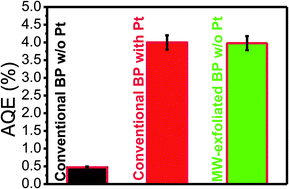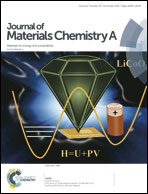p-Type BP nanosheet photocatalyst with AQE of 3.9% in the absence of a noble metal cocatalyst: investigation and elucidation of photophysical properties†
Abstract
While stability, significantly poor apparent quantum efficiency (AQE < 0.5%) and over dependence on noble metal cocatalysts is a long standing problem, here, we report, for the first time, microwave-exfoliated p-type few-layer black phosphorous (BP-nanosheets) as a stable photocatalyst for hydrogen production without any supporting noble metal co-catalyst. This few layer BP has shown a record high apparent quantum efficiency (AQE) of ∼4% at 420 nm under visible light irradiation. This unprecedented AQE stems from a low level of material oxidation that impedes the degradation of BP under ambient conditions, strong absorption of photons at the surface, and a conduction band edge position that favorably facilitates the proton reduction reaction. These BP-nanosheets have also shown superior photocatalytic performance compared to the known cohort of metal-free photocatalysts such as graphitic carbon nitride, carbon dots, and red-P under identical experimental conditions. An understanding of the photo-physicochemical reasons that drive this chemistry is elucidated along with results obtained from physicochemical characterization and finite difference time domain simulations.



 Please wait while we load your content...
Please wait while we load your content...
